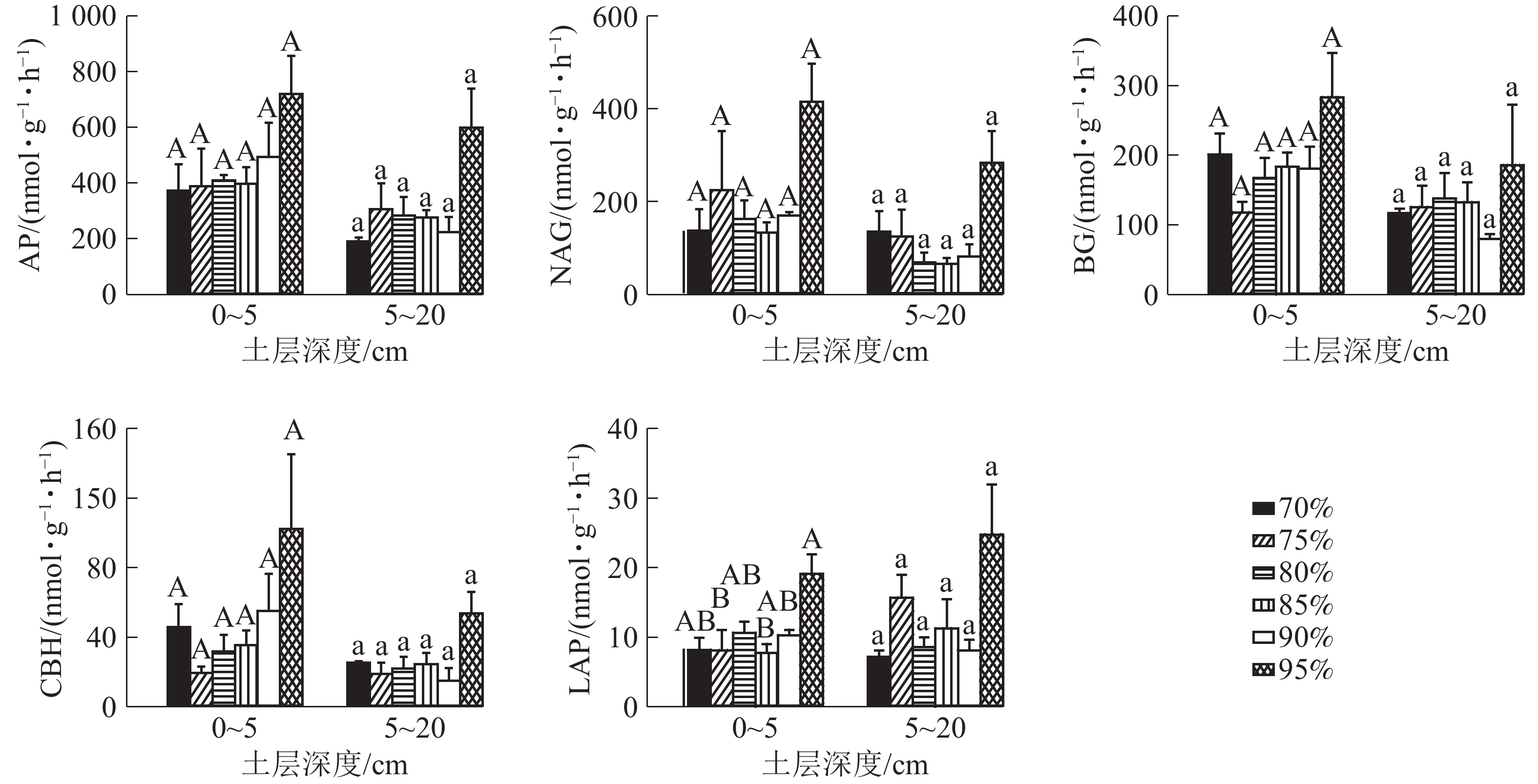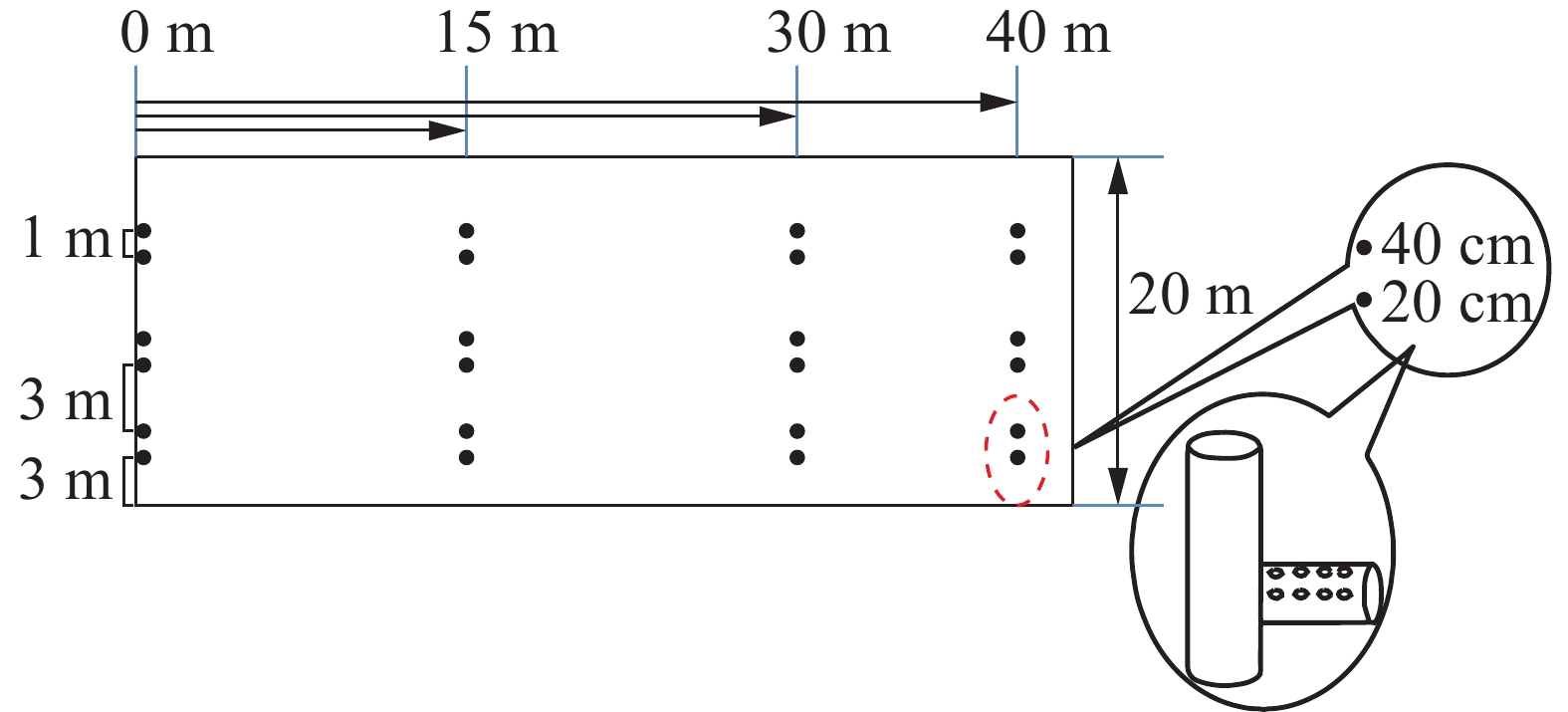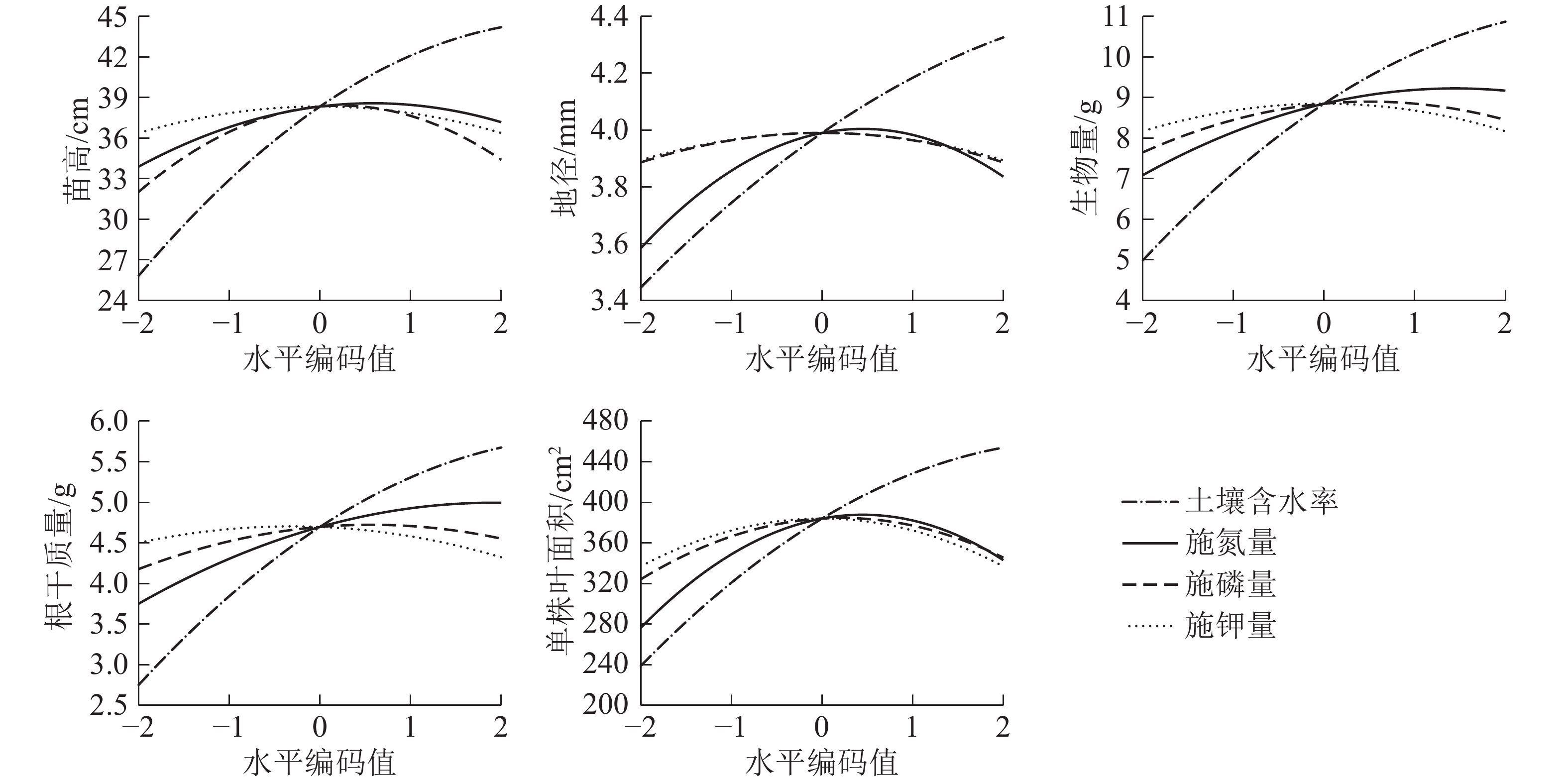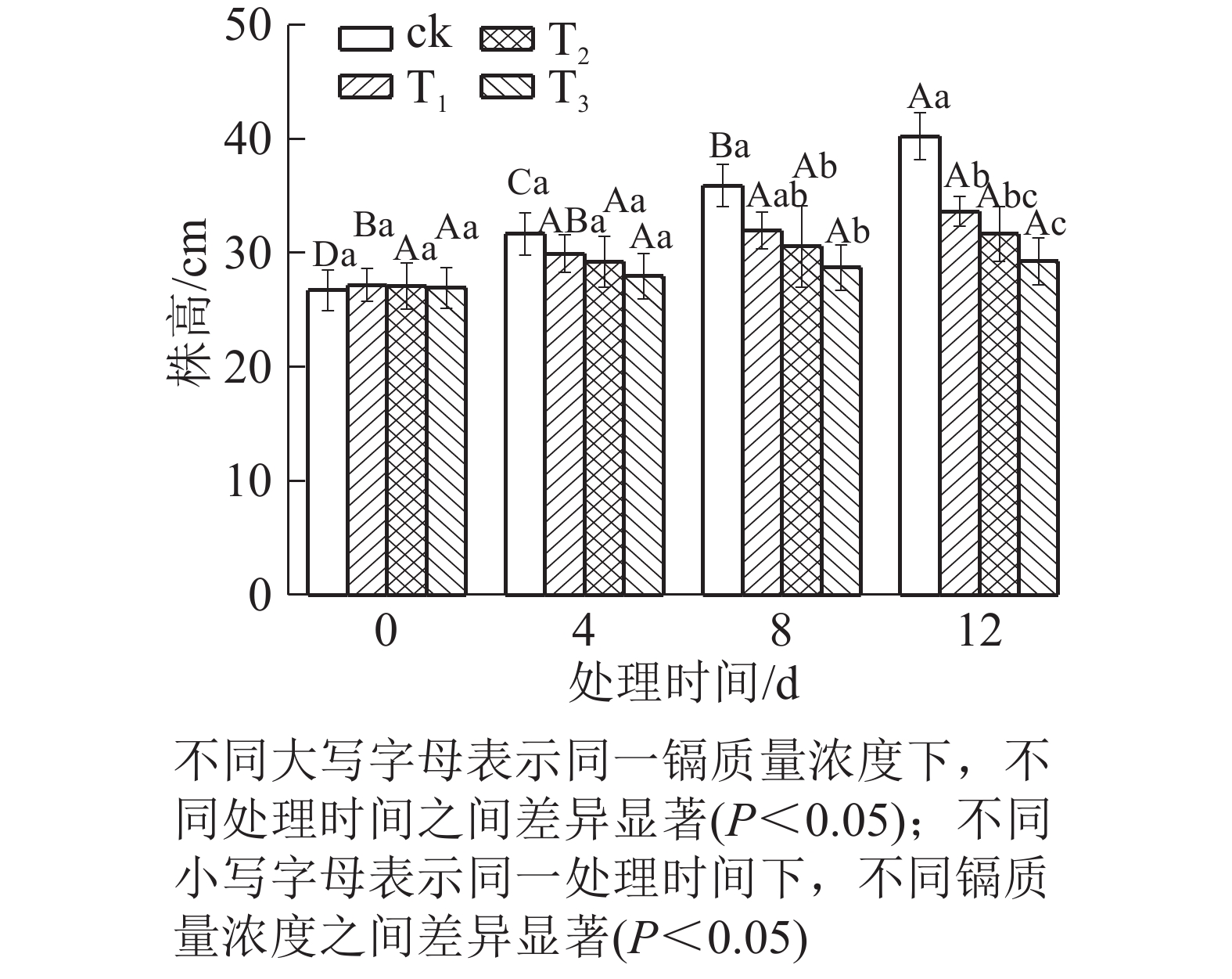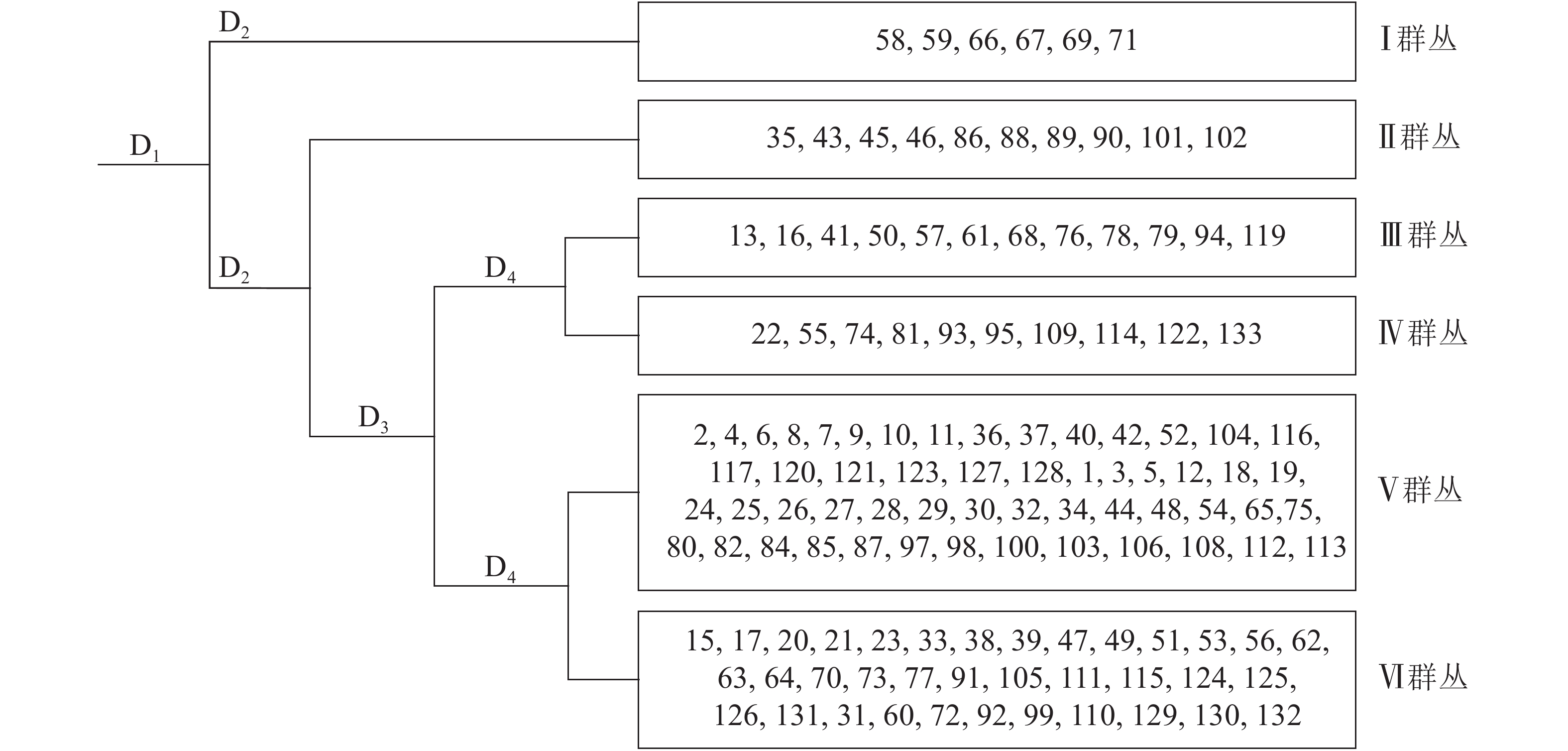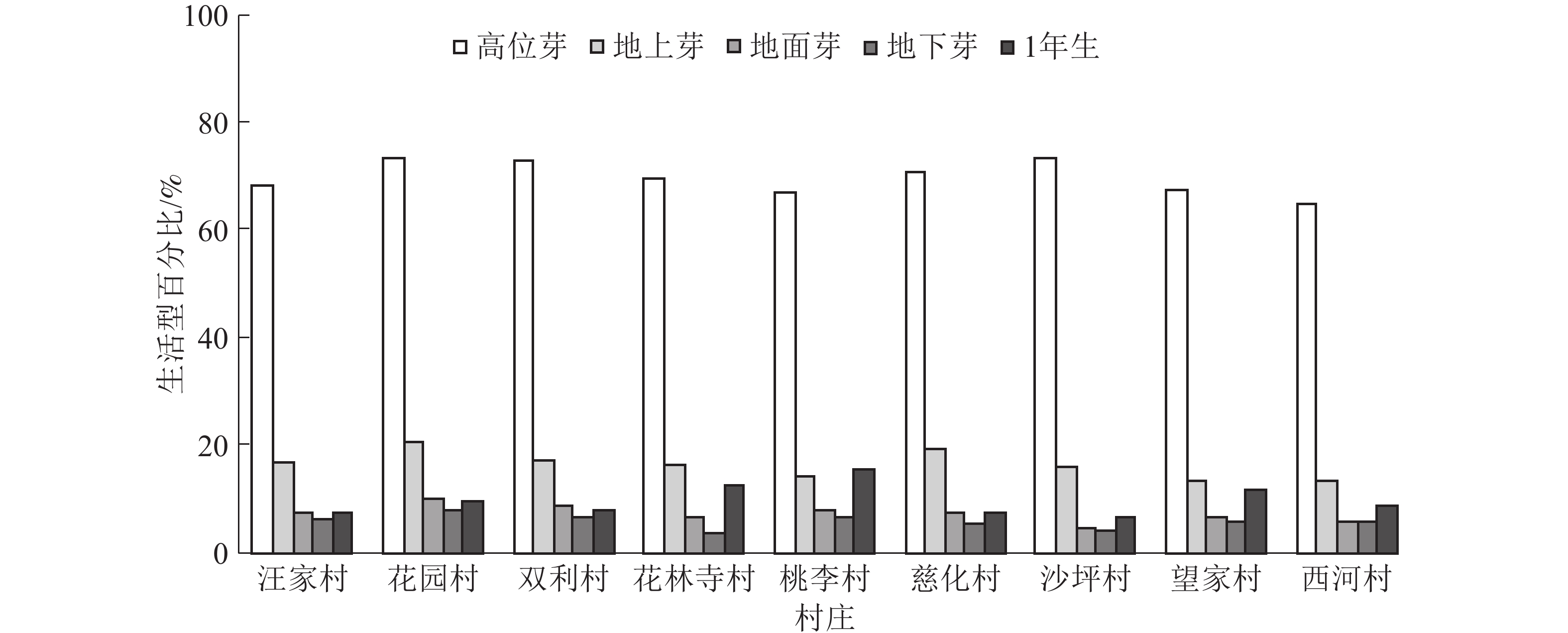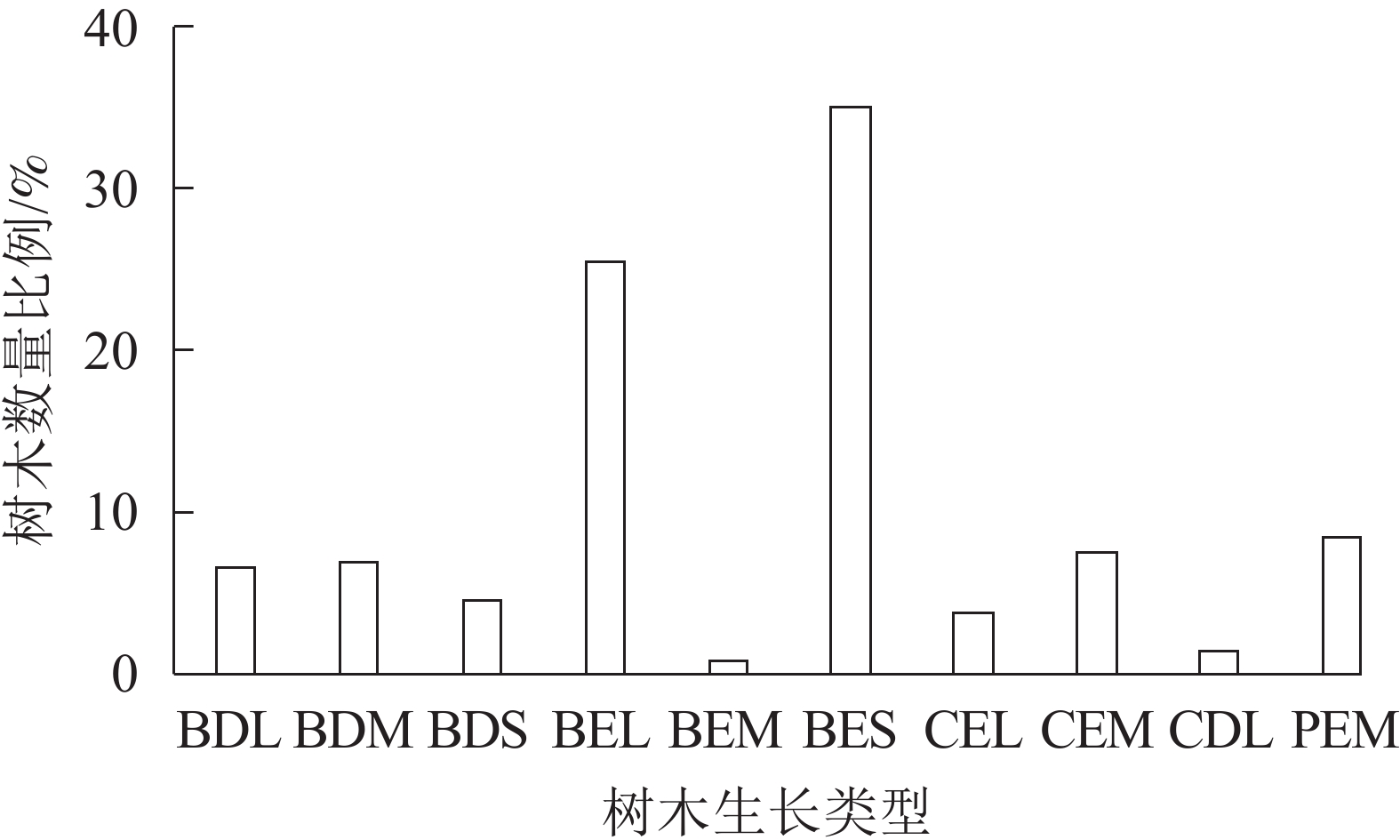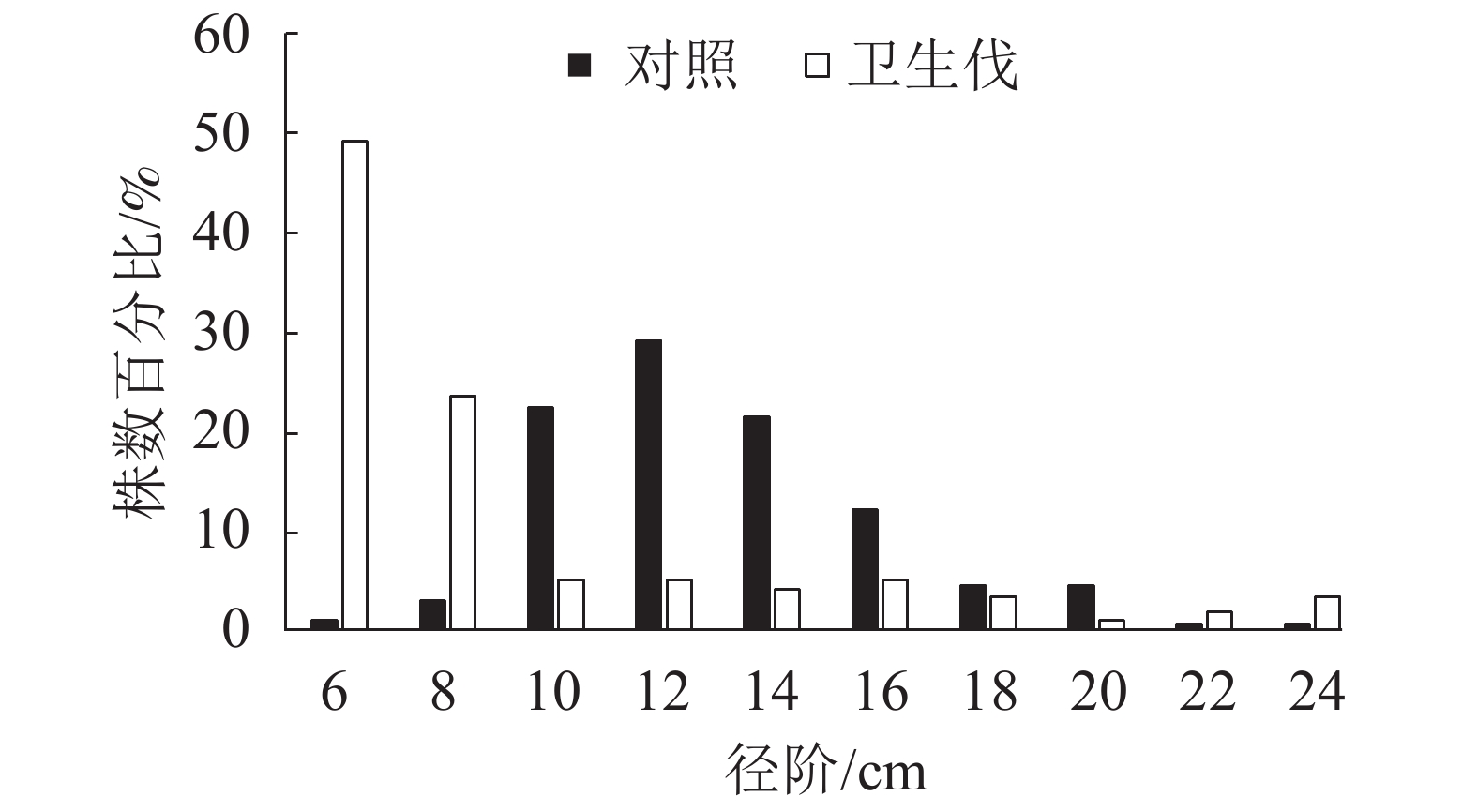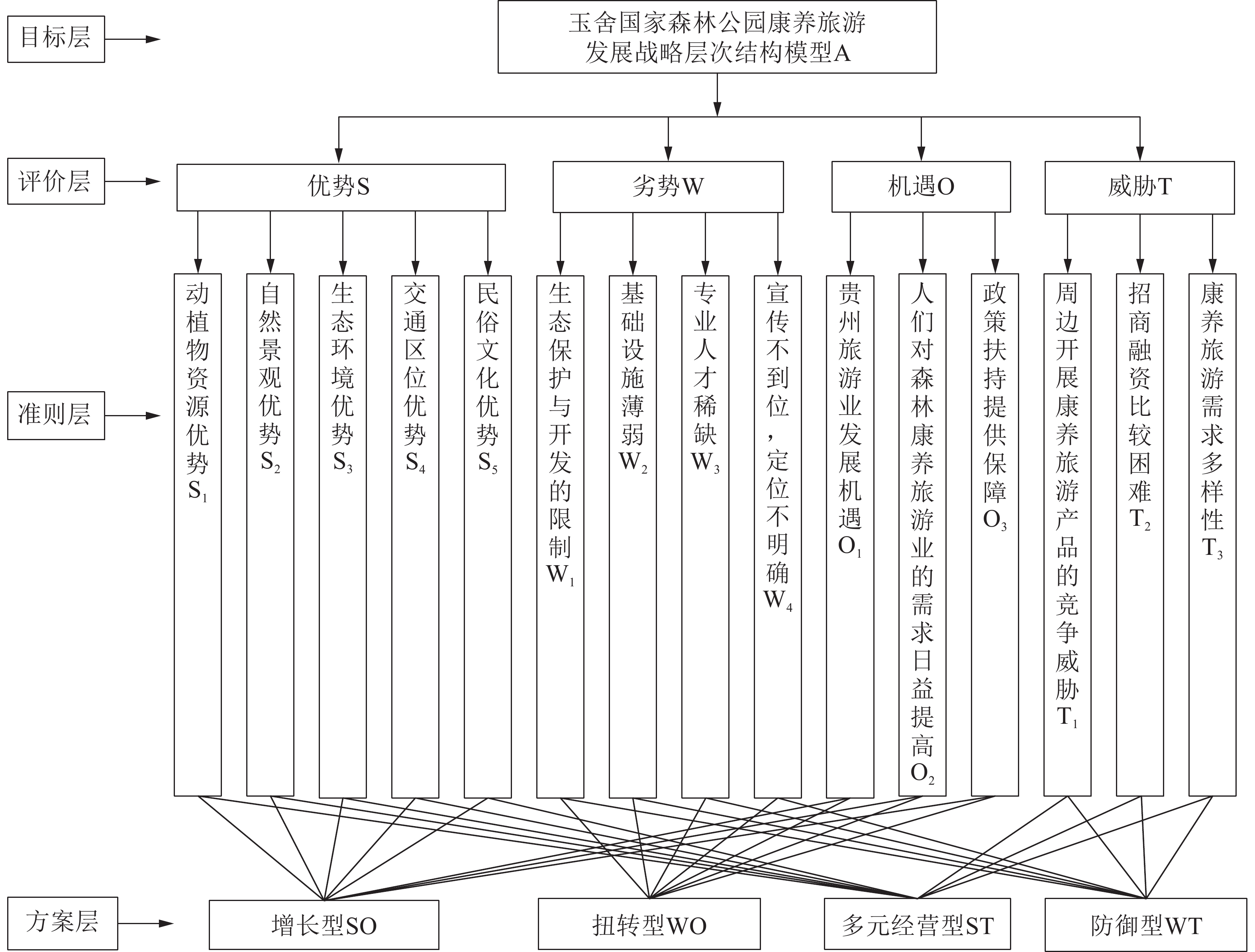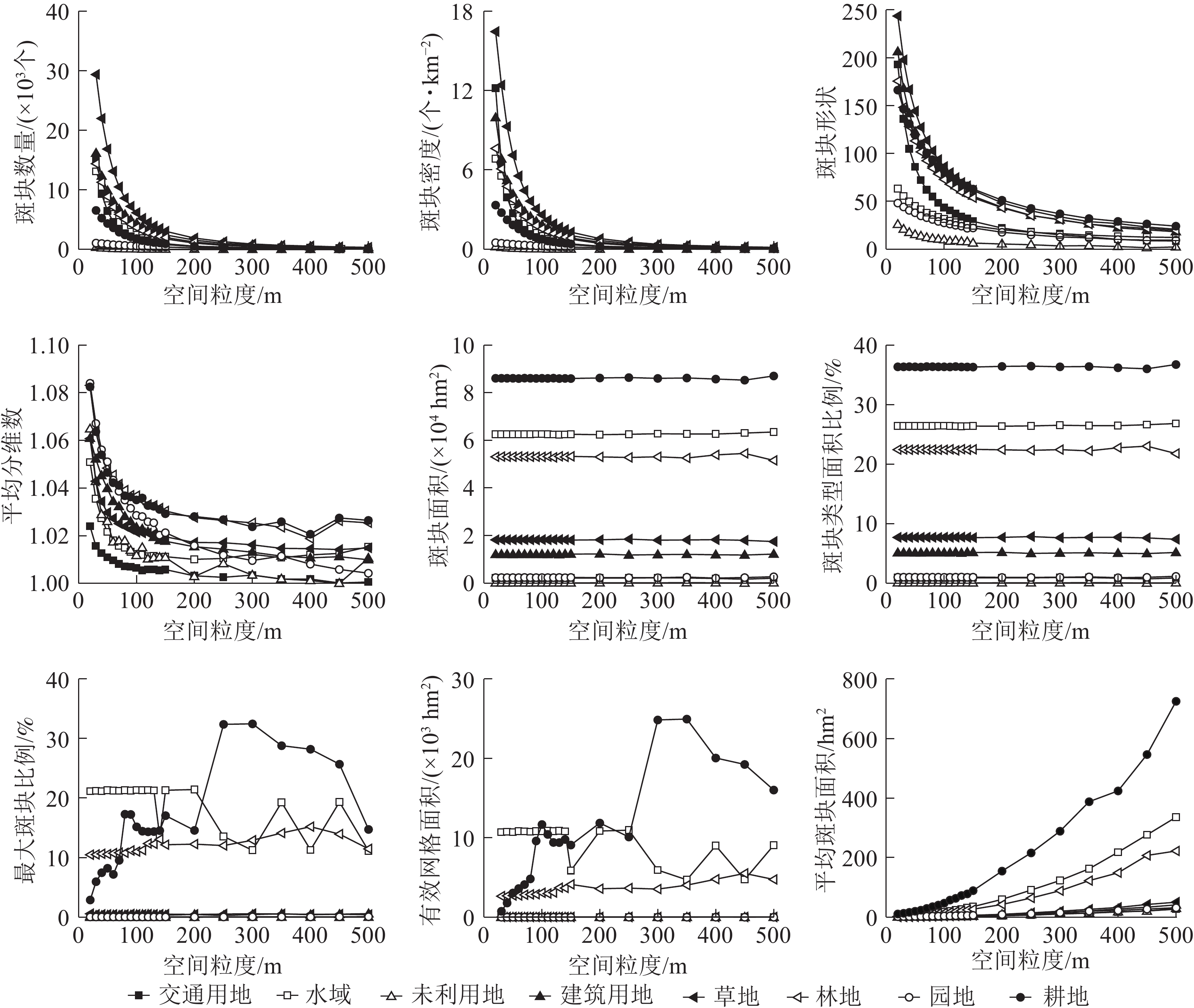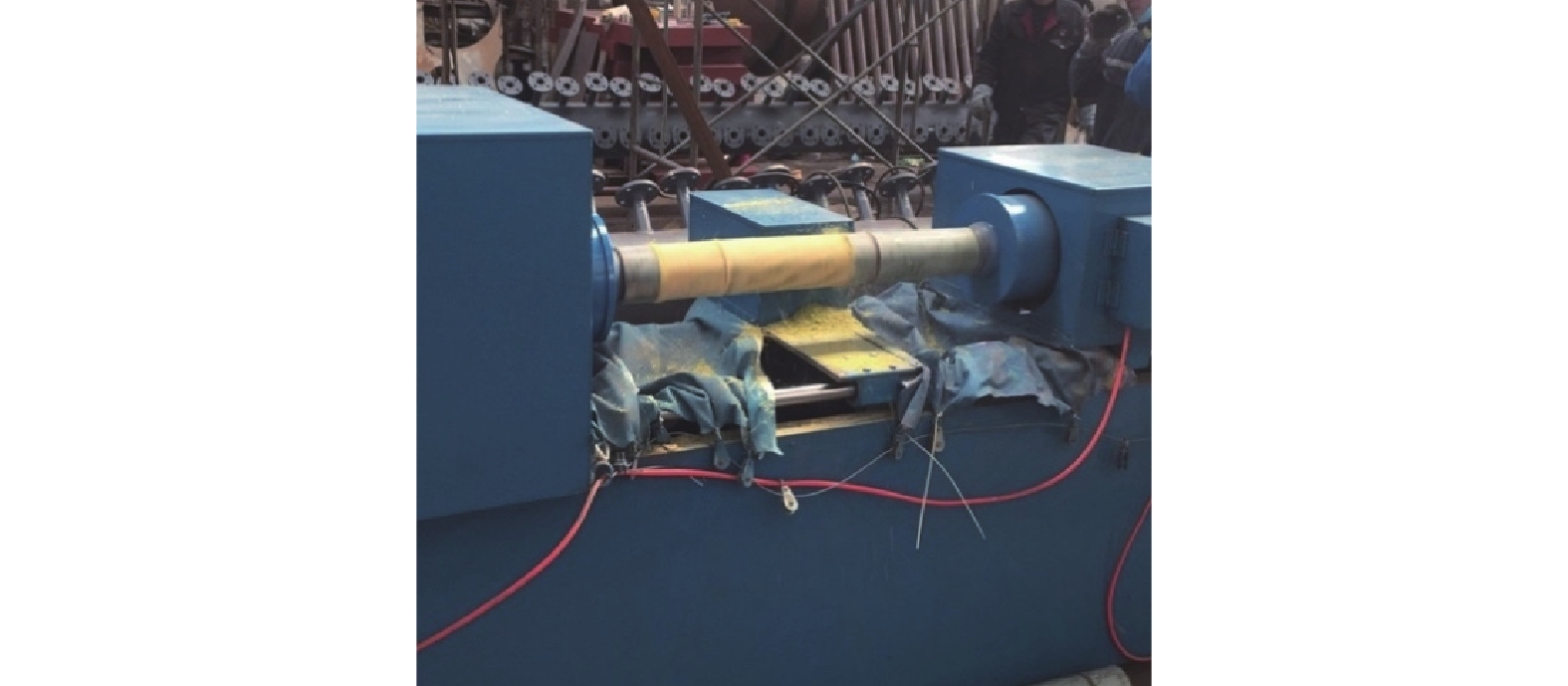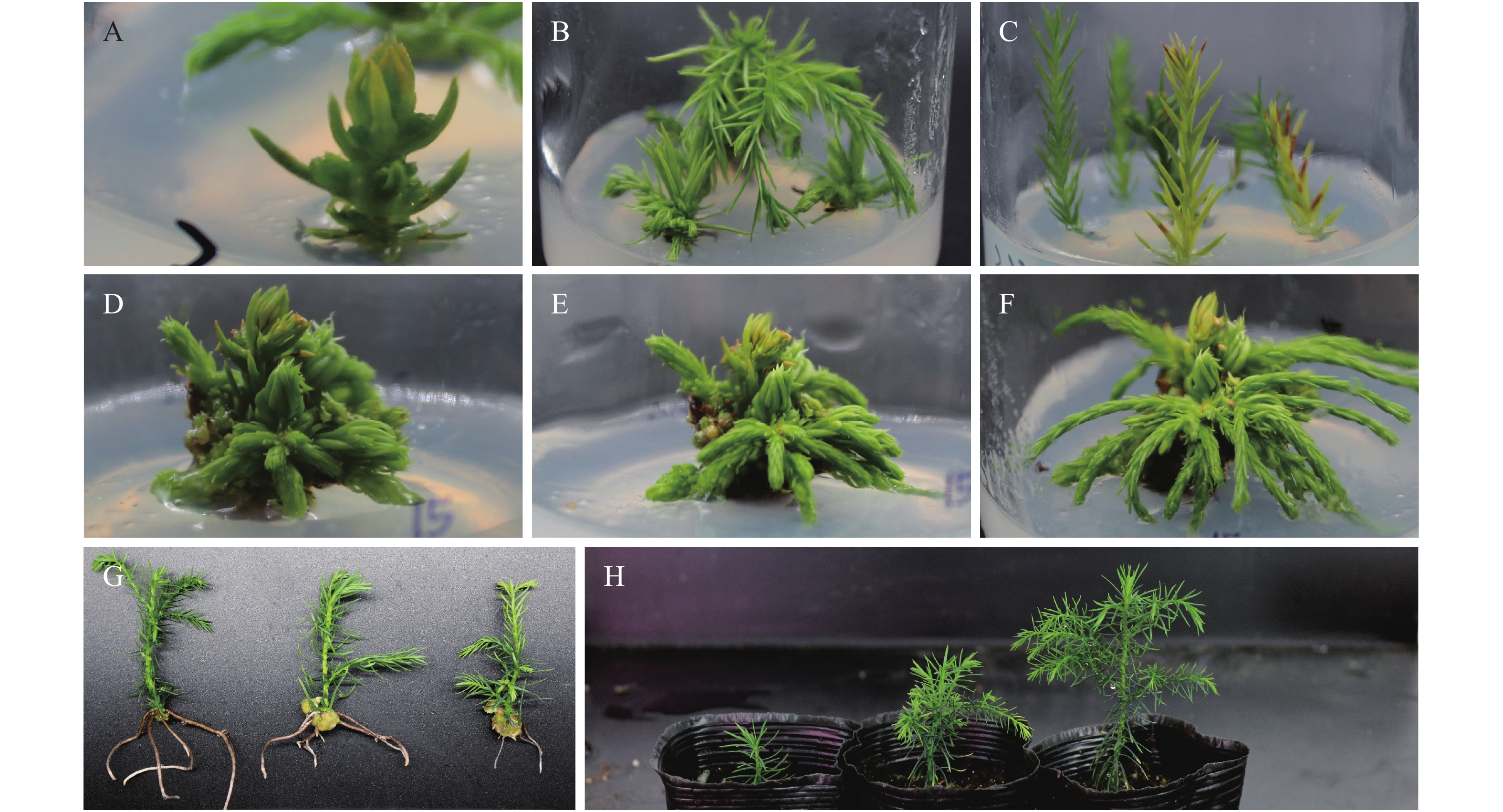2020 Vol. 37, No. 4
2020, 37(4): 611-622.
doi: 10.11833/j.issn.2095-0756.20190525
Abstract:
Objective The objective of this research is to study the chemical properties and enzyme stoichiometry of soil under different proportions of Larix gmelinii forests. Method The investigated L. gmelinii forests were classified into six groups according to its volume proportion in the community (70%, 75%, 80%, 85%, 90%, 95%), and its soil samples were monitored for the nutrient content and biochemical properties in 0−5 cm soil layers and 5−20 cm soil layers. Result Among the five enzymes analyzed, the activity of acid phosphatase was the highest, and the mean value of 0−5 and 5−20 cm soil layers were 463.74 and 312.91 nmol·g−1·h−1. In 0−5 cm soil layer, the activity of leucine aminopeptidase (LAP) was promoted by the increase of L. gmelinii proportion, and the leucine aminopeptidase activity of L. gmelinii community with 95% proportion significantly increased by 57.44% and 59.40%, compared with that of L. gmelinii community with 75% and 85% proportion. The proportion of L. gmelinii in the community also affected the chemometric characteristics of soil enzymes. When the proportion of L. gmelinii reached 95% in 5−20 cm soil layer, the ratio of nitrogen-acquiring enzyme to phosphorus-acquiring enzyme was much higher than that of L. gmelinii communities with the proportion of 80% and 85% (P95%-80%=0.02, P95%-85%=0.02). However, the ratio of carbon-acquiring enzyme to nitrogen-acquiring enzymewas lowest in forest community with 95% proportion of L. gmelinii. There existed a complex correlation between soil enzyme activity and soil nutrient content, which also changed with the increase of soil depth. In 0−5 cm soil layer, soil pH negatively correlated with the activities of glucosidase (BG), and acetylglucosaminidase (NAG) (PpH-BG=0.01, PpH-NAG=0.03). In the 5−20 cm soil layer, there existed a positive correlation between soil total nitrogen (TN) content and the activities of leucine aminopeptidase (LAP) and NAG (PLAP-TN=0.02, PNAG-TN=2×10−4), and a negative correlation between acid or alkaline phosphatase (AP) and soil total phosphorus (TP) content (PAP-TP=0.02). Through the redundancy analysis of the above variables, it was found that the enzymatic stoichiometry was greatly influenced by soil pH in 0−5 cm layer, while in 5−20 cm layer it was mainly affected by the mass fraction of soil total nitrogen and available nitrogen. Conclusion The proportion of L. gmelinii in the mixed coniferous and broad-leaved forest in warm temperate zone is an important biological factor for regulating soil nutrient dynamics, and its regulation largely relies on the activity and stoichiometric characteristics of soil enzymes. [Ch, 4 fig. 4 tab. 41 ref.]
2020, 37(4): 623-630.
doi: 10.11833/j.issn.2095-0756.20190565
Abstract:
Objective The objective is to explore distribution characteristics and seasonal variations of soil microbial biomass carbon (MBC) content at different succession stages of coastal wetlands in Jiangsu Province, and to reveal its main influencing factors. Method Five typical succession stages of coastal wetlands in Jiangsu were selected as the research objects, including coastal mudflats, Spartina auglica wetland, Suaeda glauca wetland, Phragmites australis wetland, and Robinia pseucdoacacia forest. The distribution characteristics of soil MBC at the different succession stages, the effects of vegetation succession, soil layer and season on MBC, the relationship between soil MBC and soil physical and chemical properties were analyzed. The key factors affecting soil MBC in coastal wetlands were discussed. Result Soil MBC content ranged from 116.91 to 326.18 mg·kg−1, with a significant difference between different succession stages, but the distribution trend was not consistent with the succession direction. The highest was Sp. auglica, followed by P. australis, coastal mudflats, Su. glauca, and R. pseucdoacacia. In 0−10 cm soil depth, soil MBC content in Sp. auglica wetland was significantly higher than that of other succession stages in four seasons. Soil MBC content at different succession stages first increased and then decreased with variation of seasons in the three soil layers, reaching its peak in autumn but lower in spring or winter. Soil MBC in coastal wetlands was significantly affected by seasons and succession stages, among which the seasonal factors had the largest impact, accounting for 32.29%. There existed a significant positive correlation between soil MBC content and total organic carbon, total nitrogen and soil moisture content, but a significant negative correlation with soil pH. Conclusion Vegetation succession and seasons are the main factors affecting the distribution and dynamic characteristics of soil MBC in coastal wetlands, among which seasonal factors have the greatest influence, and soil organic matter, moisture content and pH are the key factors that directly affect soil microbial activity. [Ch, 1 fig. 2 tab. 35 ref.]
2020, 37(4): 631-638.
doi: 10.11833/j.issn.2095-0756.20190462
Abstract:
Objective To establish a scientific fertilization system for Zizyphus jujuba ‘Lingwuchangzao’, the current study is aimed to figure out the correlation of soil, leaves and fruit nutrients with the quality of the above mentioned jujube. Method With the soil, leaves and fruit nutrients of 5 Z. jujuba ‘Lingwuchangzao’ as the study subjects, by using the multiple linear stepwise regression analysis the relationship between fruit quality with the soil fertility and leaf nutrients was established. Result The soil fertility properties of different planting bases were significantly different, and Mn was generally lacking in planting bases. The longitudinal diameter of fruit was negatively correlated with the soil total K, the fruit hardness and the fruit N content. The fruit titration acid content was positively correlated with the content of soil available K, leaf P and fruit N, but negatively correlated with the content of fruit Fe. The content of fruit N was positively correlated with the content of soil organic matter, leaf Fe and fruit Zn, but negatively correlated with the content of soil Se. The K content of fruit was negatively correlated with the effective Fe content of soil, but positively correlated with the total P content of soil. The content of Zn in fruits was positively correlated with the content of available K in soil, Zn in leaves and N in fruits. Conclusion The application amount of organic fertilizer and trace element fertilizer should be increased in the planting bases of Z. jujuba ‘Lingwuchangzao’, especially that of Mn, while that of Fe should be reduced. [Ch, 11 tab. 24 ref.]
2020, 37(4): 639-645.
doi: 10.11833/j.issn.2095-0756.20190509
Abstract:
Objective The discharge of agricultural non-point source pollutants such as phosphorus has become one of the major causes for the eutrophication in Taihu Lake. Riparian vegetation buffer strips can reduce non-point source pollution from agricultural area into water through absorption and interception. The riparian vegetation strips were built on gentle slopes to study the efficiency of retaining phosphorus so as to provide a scientific basis for mitigating the pollution of agricultural non-point sources in Taihu Lake. Method Taking the buffer strip of plantation along the bank of Taihu Lake as the research object, the interception effects of riparian plantation buffer strips with different widths (15, 30, 40 m), densities (400, 1 000, 1 600 trees ·hm−2 ), plantation types (Populus × euramericana ‘Nanlin 95’ plantation, Taxodium hybrid ‘Zhongshanshan’ plantation and ‘Nanlin 95’-‘Zhongshanshan’ mixed plantation) and ages (3, 4, 5, 6 a) on total phosphorus (TP) and dissolved phosphorus (DP) in surface runoff water were studied to determine the suitable structure of vegetation buffer strips. Result The 30 m wide buffer strips had the optimal effect on intercepting phosphorus in runoff water, and the TP interception rate was the highest at 30 m, 77.30%. The interception rate of DP increased with the increase of buffer strips width but there existed no significant difference between different widths of buffer strips in terms of DP interception rate (P>0.05). The stand density of riparian buffer strip with good interception effect on TP and DP in runoff water was 1 000 trees ·hm−2, and the interception rate was 84.29% and 93.25%, respectively. The ‘Nanlin 95’ plantation could intercept 82.37% TP in runoff water while the interception rate of ‘Nanlin 95’- ‘Zhongshanshan’, the mixed plantation on DP was a little higher than that of Conclusion The 30 m wide buffer strips can meet the requirement of pollution interception, and the
2020, 37(4): 646-653.
doi: 10.11833/j.issn.2095-0756.20190531
Abstract:
Objective This research aims to explore the water consumption characteristics of Eucalyptus urophylla at night and its driving factors, and provide data support for improving the estimation accuracy of water consumption in large scale eucalyptus forests. Method Using thermal dissipation probe(TDP) technique, E. urophylla, a common eucalyptus from Leizhou Peninsula, was chosen as the research object to continuously observe its nocturnal sap flow and simultaneously measure the main environmental factors such as atmospheric temperature, humidity, rainfall and photosynthetically active radiation. The characteristics and the driving mechanism of sap flow at night were discussed in depth. Result The results indicated that the average water consumption contribution rate of E. urophylla at night during the observation period was 6.62%, and the first half of the night consumed significantly more water than the second half (P<0.05). The nocturnal flow rate was significantly higher in the rainy season than in the dry season (P<0.05). The average nocturnal flow rate was extremely significantly higher on sunny days than on rainy days (P<0.01). The nocturnal water consumption contribution rate in the dry season is 1.4 times that in the rainy season. Nocturnal flow rate was significantly and positively correlated with vapor pressure deficit(P<0.01)during the dry and rainy seasons, and the fitting equation was of high statistical significant. However, the coefficient of determination was only 0.37 and 0.35 for the dry season and the rainy season, respectively. Meanwhile, there was an extremely significant positive correlation between the nocturnal water consumption and the daytime transpiration (P<0.01), and there was a power function relationship with a determination coefficient of 0.33. Conclusion Nocturnal water consumption accounts for a small proportion of the total transpiration volume. However, if nocturnal sap flow is fully ignored, total water consumption of the E. urophylla plantation ecosystem based only on the daytime sap flow can be underestimated. Nocturnal transpiration and trunk hydration together drive the E. urophylla’s nocturnal water consumption. [Ch, 4 fig. 2 tab. 27 ref.]
2020, 37(4): 654-663.
doi: 10.11833/j.issn.2095-0756.20190521
Abstract:
Objective The objective is to study the effects of volatile organic compounds (VOCs) from three evergreen plants on air microorganism inhibition and air purification. Method The composition and content of VOCs in Myrica rubra, Vatica mangachapoi, Camellia sinensis in single tree and open field were analyzed using thermal desorption system/gas chromatography/mass spectrometry (TDS-GC-MS) technique. The effect of VOCs on airborne microorganism was investigated by natural sedimentation method, and the number of air anion was measured. Result The main VOCs of M. rubra were α-oxalene, parsley alcohol, rolene, limonene and nonaldehyde, in which terpenes accounted for 78.5% of the total. The main VOCs of V. mangachapoi were acetyl acetate, octyl butyrate, cis-3-hexenol, pinocarvone, nonanal, decanal, and octanal, in which ester compounds accounted for 54.1% of the total. Acetyl acetate, octyl butyrate, methyl salicylate, nonanal, decanal, limonene were the main VOCs of C. sinensis, and ester compounds accounted for 40.8% of the total. The VOCs in open space were benzene, accounting for 74.2% of the total. The VOCs in M. rubra garden were benzene and terpene, accounting for 54.8% and 35.6%, respectively. The VOCs in V. mangachapoi garden were benzene and terpene, accounting for 35.4% and 52.2%, respectively. The VOCs in C. sinensis garden were benzene and terpene, accounting for 50.1% and 36.5%, respectively. The daily average number of air anion in M. rubra garden, V. mangachapoi garden, C. sinensis garden, and the open space was 2 559.2, 2 660.0, 1 878.4, 1 078.8 per cubic centimeter, respectively. In M. rubra garden, V. mangachapoi garden, and C. sinensis garden, daily average bacterial inhibition rate was 45.5%, 48.7% and 39.3%, respectively, daily average inhibition rate of fungi was 39.0%, 35.8% and 34.6%, respectively, and that of actinomycetes was 42.3%, 42.2% and 39.7%, respectively. Conclusion Plant VOCs can inhibit the growth of airborne microorganism, promote the formation air anion and improve the air quality. [Ch, 5 fig. 2 tab. 38 ref.]
2020, 37(4): 664-672.
doi: 10.11833/j.issn.2095-0756.20190398
Abstract:
Objective The objective of this research is to reveal the photosynthetic characteristics and the development of photosystem of the stem of Phyllostachys edulis. Method Blue-greengel electrophoresis (BN-PAGE) was used to analyze the thylakoid membrane proteins in stems and leaves, and the changes in pigment content and the 77 K low temperature fluorescence emission spectrum were measured. Result The content of chlorophyll and carotenoid in stems was significantly lower than that in leaves (P<0.01), and with the development of stems, the pigment content increased significantly. The core complex of PSⅡ in the thylakoid membrane of stems and leaves was relatively complete and there were more light-catching pigments. PsaA/B and PsaD subunits were mainly isolated from PSI core complex in leaves and the stem base, and PsaA/B was obtained from the middle of stem, but no PsaA/B was found at the top of stem. There were two obvious main peaks at 685 and 745 nm in the 77 K low temperature fluorescence emission spectrum of leaves and stems, and six maximum values in the fourth derivative spectrum, which were mainly the fluorescence emission peaks of the core complex of PSⅡ and PSⅠ, and the shoulder peak caused by the emission fluorescence peak of the PSⅡ peripheral light catching antenna (LHC Ⅱ), PSⅡ inner peripheral light catching antenna (CP47), PSⅡ inner peripheral light catching antenna (CP43), PSⅠ reaction center complex (RCI), and PSI light catching antenna (LHC Ⅰ). The characteristic emission peak of LHC Ⅱ and PSⅡ core complex at the top of stem had obvious blue shifts compared with that of leaves. Conclusion The core complex of PSⅡ in stems of Ph. edulis has been formed. With the development of stems, the bamboo shoot coat gradually falls off, the pigments are synthesized in large amount, the inner antenna proteins CP47 and CP43 and the peripheral light-catching complex are formed gradually. Meanwhile, the PSⅠ core proteins PsaA and PsaB begin to form after the stems are exposed to light, and the core complex of PSⅠ is gradually assembled and synthesized. [Ch, 4 fig. 2 tab. 45 ref.]
2020, 37(4): 673-682.
doi: 10.11833/j.issn.2095-0756.20190456
Abstract:
Objective The aim is to investigate the response of stem height, ground diameter, leaf area, root weight and biomass accumulation of the seedlings of Quercus variabilis to the coupling of water and fertilizer, and to establish optimal combination of irrigation and fertilization. Method The four-factor-five-level quadratic regression general rotatable central composite design(RCCD) was employed to establish the regression model of each index and soil moisture (W), nitrogen (N), phosphorus (P) and potassium (K), with an analysis conducted of the main effect, monofactor and coupling effect of each factor on growth. Result (1)With the variance analysis of the stem height, ground diameter, leaf area, root weight and biomass, it was found that there is a significant divergence in the treatment of various factors (P<0.05) and the growth of seedling 8,16 and18 is the most favorable. (2) The model test results show that W and N have significant positive effect on all 5 indexes, P has no significant effect on ground diameter, K has no significant effect on any indexes, and there is a decrease of the main effect: W>N>P>K. (3) In terms of monofactor effect, it was shown that all the indexes presented a trend of first increase and then decrease with the increase of fertilizer application, in the path of a parabola. There was a gradual growth of the seedling with the increase of W before the a drop occurred in the growth rate. (4) With the anlaysis of the coupling effect, it was found that W×N has significant positive effects on stem height, root weight, biomass and leaf area, W×P has significant positive effects on stem height, ground diameter, root weight and biomass, W×K has significant positive effects on biomass, and N×P has significant positive effects on root weight, leaf area and biomass, N×K has significant negative effects on the ground diameter and the coupling effect between water and fertilizer is greater than that between fertilizers. Conclusion In conclusion, the water and fertilizer demand in the seedling stage of Q. variabilis is W>N>P>K, and suitable water and fertilizer ratio can promote the growth of seedlings. Seedlings grow better with conditions of high water, high nitrogen, high phosphorus and low potassium fertilizer. The optimal combination of water and fertilizer regulation was as follows: soil water content was 79% of the maximum field moisture capacity, nitrogen application was 215.3 mg·plant−1, phosphorus application was 46.0 mg·plant−1, potassium fertilizer application was 18.1 mg·plant−1, with seedling height reaching 45.14 cm, ground diameter reaching 4.40 mm, root weight reaching 6.30 g·plant−1,biomass reaching 11.70 g· plant−1, and leaf area reaching 460.83 cm2. [Ch, 3 fig. 2 tab. 30 ref.]
2020, 37(4): 683-692.
doi: 10.11833/j.issn.2095-0756.20190407
Abstract:
Objective The purpose of this study is to observe the physiological responses of Hygroryza aristata to cadmium (Cd) stress, for protection and utilization of H. aristata. Method The effects of cadmium on the growth, photosynthetic physiology and antioxidant enzyme activities of H. aristata were studied using hydroponic test in which plants of H. aristata were treated with cadmium at concentrations of 0 (ck), 2 (T1), 4 (T2), and 6 (T3) mg·L−1 and sampled at 0, 4, 8 and 12 days after treatment. Result The plant height of H. aristata gradually decreased as the concentration of cadmium increased. By 12 days after treatment, the plant height of T1, T2 and T3 was 16.35%, 21.27% and 27.29% lower than that of ck, respectively. Similarly, the total length of roots and the total number of root tips decreased significantly(P<0.05). The mass fraction of total chlorophyll, chlorophyll a and chlorophyll b in the leaves of H. aristata decreased, so did chlorophyll a/b. The net photosynthetic rate (Pn) dropped significantly(P<0.05). By 12 days after treatment, Pn in T1, T2 and T3 decreased by 55.44%, 58.77% and 96.47% respectively, compared with ck. After treatment for 8 days, Pn, the transpiration rate (Tr), and the stomatal conductance (Gs) in T1, T2 and T3 decreased significantly (P<0.05), while the intercellular CO2 concentration (Ci) increased significantly (P<0.05). Compared with ck, the mass molality of hydrogen peroxide (H2O2) and malondialdehyde (MDA) in the leaves of H. aristata increased gradually with the increase of cadmium concentration. With the extension of treatment time, the increasing rate of H2O2 and MDA mass molality in each treatment showed a downward trend, and the maximum increasing rate occurred between 0−4 d after treatment. The proline (Pro) content in T3 first increased and then decreased, reaching a peak on day 8 and decreasing by 53.85% on day 12 compared with ck. The activities of superoxide dismutase (SOD), peroxidase (POD) and catalase (CAT) in the leaves of treated H. aristata plants gradually increased with the increase of cadmium concentration. Conclusion Cadmium has a serious toxic effect on H. aristata, whose growth and photosynthetic activities are obviously inhibited under cadmium stress. Long-term cadmium stress limits the activity of antioxidant enzymes in removing reactive oxygen species (ROS) and protecting against oxidative damages, which further weakens the ability of H. aristata to resist adverse stress. [Ch, 4 fig. 2 tab. 47 ref.]
2020, 37(4): 693-701.
doi: 10.11833/j.issn.2095-0756.20190514
Abstract:
Objective This study aims to indicate the distribution of forest community and species diversity on the gradients of complex environment by classifying and sorting the community of ecological non-commercial forest in Songyang County, Zhejiang Province, and discussing the change law of diversity and interspecific relationship. Method Taking 128 monitoring plots as research projects, two-way indicator species analysis (TWINSPAN), canonical correspondence analysis (CCA), species diversity index and interspecific association analysis were used to study the community characteristics of non-commercial forest in Songyang County. Result TWINSPAN results showed that the forest community could be divided into 6 types. CCA results demonstrated that the community distribution and types of non-commercial forest in Songyang County showed obvious differentiation on environmental gradient, which was mainly affected by altitude, soil type and slope aspect. The results of multiple comparison of species diversity showed that the Shannon-Wiener index and Simpson index of associations with mixed forest or broad-leaved forest were significantly higher than those of other associations, and the diversity of association dominated by Phyllostachys edulis was significantly lower than that of other associations. Interspecific Association Analysis illustrated that most tree species in sample plots had no significant correlations. The positive and negative correlation ratio was 1.9, indicating the overall stability of the community. Conclusion Differential management should be carried out for the non-commercial forest in Songyang County, and mixed and broad-leaved forests should be actively promoted. It is possible to consider different supplementing measures for the non-commercial forests with different site conditions and different stands. The edge control of bamboo forests and community combinations that can adapt to various environments should be properly promoted. [Ch, 4 fig. 3 tab. 37 ref.]
2020, 37(4): 702-709.
doi: 10.11833/j.issn.2095-0756.20190428
Abstract:
Objective This study aims to explore the species composition, structure and characteristics of wild Phoebe and Machilus communities in Yuan’an County, Hubei Province, and improve the distribution record of wild Phoebe and Machilus resources in Yichang area. Method The field investigation of the wild Phoebe and Machilus communities in Mingfeng Town, Hualinsi Town and Leizu Town of Yuan’an County was carried out by using quadrat method to record the habitat conditions and species distribution of Phoebe and Machilus plants, and the method of Community Ecology was used for statistical analysis. Result (1) There were 2 species of Phoebe and 3 species of Machilus plants in the survey area, including Phoebe neurantha and Ph. faberi in Ph. genera, and M. ichangensis, M. pauhoi and M. ultinervia in Machilus genera. M. pauhoi and M. multinervia were identified as new distribution record species in Yuan’an County. (2) There were 73 species of vascular plants belonging to 35 families and 61 genera, among which 21 families were single genera and single species. The high bud plants had the largest distribution in the community, while the underground and surface buds had the least. The DBH levels of most species were in grade Ⅲ (5.0 cm ≤ DBH<7.5 cm)and Ⅳ(7.5 cm ≤ DBH<22.5 cm), with a few species in grade Ⅴ(DBH≥22.5 cm). Shannon-Wiener diversity index H′, Simpson dominance index Ds and evenness index Jsw showed no significant difference among the three townships(P>0.05), but Margalef richness index R did(P<0.05). Conclusion Yuan’an County is rich in wild Phoebe and Machilus resources, with high species diversity index and reasonable community structure. However, the protection of local wild Phoebe and Machilus resources should be further strengthened. [Ch, 3 fig. 3 tab. 28 ref.]
2020, 37(4): 710-719.
doi: 10.11833/j.issn.2095-0756.20190472
Abstract:
Objective Phyllostachys edulis(Moso bamboo) forest is one of the forest community types that have been expanding in the subtropical region of China in recent 30 years. The spread and invasion of Ph. edulis forests are becoming more and more serious, threatening the vegetation around the Moso bamboo forest. It has become an important problem of forestry ecological construction at present and in the future. The study aim is to know the type and species diversity of natural regeneration community, and their influencing factors after clear cutting of Moso bamboo forest. Method This paper is based on the monitoring data of secondary communities formed by natural regeneration after clear cutting of Moso bamboo forest in Mount Tianmu, TWINSPAN analysis was used to classify the natural regeneration communities, The differences of α diversity among different communities were compared, the influence of environmental factors was analyzed by redundancy analysis. Result (1)Species and types of natural regeneration community are varied after clear-cutting of Moso bamboo forest, can be divided into 11 different communities. There were significant differences in alpha diversity among different communities. (2) Through redundancy analysis, it was found that among the three topographic factors of elevation, slope direction and slope, elevation was the main factor that determined the alpha diversity of woody layer and herbaceous layer of natural regeneration community and was significant negatively correlated with it(P<0.05). Conclusion This paper reveals the distribution pattern of community and environmental factors in the early stage of succession and provides theoretical basis for vegetation restoration in the protected area. [Ch, 3 fig. 3 tab. 38 ref.]
2020, 37(4): 720-728.
doi: 10.11833/j.issn.2095-0756.20190498
Abstract:
Objective This study aims to investigate the species composition, biological diversity and structural characteristics of natural secondary forest communities with different restoration ages in the karst area at the head of canal in the middle route of the South-to-North Water Diversion Project, and to understand the vegetation status in the karst area, so as to provide scientific basis for regional vegetation protection and restoration, biodiversity protection and comprehensive management and evaluation of rocky desertification. Method Using the research method of “space instead of time”, and taking 6 kinds of natural secondary forests (20, 28, 35, 40, 53, 70 a) in the karst area of Xichuan County as the research object.The tree layer, shrub layer and herb layer were investigated according to the method for forest community survey, and the important value of community species, diversity index, community structure and community similarity coefficient were calculated. Result A total of 63 species of vascular plants belonging to 40 families and 58 genera were found in 18 fixed plots of 10 800 m2. With the increase of recovery years, the species richness increased continuously, and most of the increased species belonged to single family, single genus and single species. The species diversity index of each layer showed different characteristics with the increase of recovery years, but the overall trend was slowly rising. Shannon diversity index, Simpson diversity index and Pielou evenness index of tree layer were the highest in P5 plots (recovery time 53 a), and the lowest in P1 plots (recovery time 20 a). Shannon diversity index and Simpson diversity index of shrub layer and herb layer increased slowly. The results of Jaccard similarity coefficient showed that there was a very different level of similarity between plots with different recovery years, and the species composition was quite different. Except for the density, there were significant differences in community average height, coverage, DBH and other structures between 20 and 70 a after restoration (P<0.05), and there was no significant difference among the others. Conclusion Compared with the karst areas in southwest China, the species richness in the karst area at the head of canal in the middle route of the South-to-North Water Diversion Project is relatively low, and Quercus variflora is the dominant species in the communities, with single family, single genus and single species being the majority, and the difference between communities is large. In the later period of vegetation restoration in the karst area, vegetation grows slowly, and the tree height and DBH are mainly concentrated in grade Ⅱ and Ⅲ. [Ch, 2 fig. 5 tab. 34 ref.]
2020, 37(4): 729-736.
doi: 10.11833/j.issn.2095-0756.20190464
Abstract:
Objective This research aims to analyze the plant community structure of Qianwangling Park in Lin’an District of Hangzhou City, Zhejiang Province, and evaluate its ecological benefits. Method Taking Qianwangling Park as the research object, the structure of 32 plant communities in the park was investigated, and the i-Tree model was used to evaluate the ecological benefits of community including energy conservation, carbon dioxide absorption, air quality improvement and rainwater interception. Result (1) There were 1 613 trees in the community, belonging to 39 families 62 genera and 74 species. The community structure was mainly of the multi-layer type, dominated by the landscape style of the mixed forest of needles and broads. (2) The annual ecological benefit of the community was 208 588.16 yuan·a−1, and the average benefit per tree was 129.25 yuan·plant−1·a−1, among which the benefits of energy conservation, carbon dioxide absorption, air quality improvement and rainwater interception were 48 188.80, 98 447.36, 4 019.84 and 57 932.16 yuan·a−1, accounting for 23.10%, 47.20%, 1.93% and 27.77% respectively. The highest total value of ecological benefits reached 12 777.60 yuan·a−1, found in sample L21 (Cinnamomum camphora+Magnolia grandiflora-Camellia japonica community), accounting for 6.13%. This community had the highest benefits in saving energy, absorbing carbon dioxide and intercepting rainwater. The mixed community contributed the most to ecological benefit values, accounting for 35.47%. (3) The deciduous broad-leaved and coniferous trees had higher average benefits per plant, and deciduous broad-leaved trees had more advantages in energy conservation, CO2 absorption, air quality improvement and rainwater interception. Conclusion The ecological benefit of plant community in Qianwangling Park is mainly determined by the number of tree species, growth type and average diameter at breast height. The coniferous and broad-leaved mixed community has obvious advantages in ecological benefit value. [Ch, 2 fig. 4 tab. 23 ref.]
2020, 37(4): 737-744.
doi: 10.11833/j.issn.2095-0756.20190538
Abstract:
Objective Alien invasive plants have huge negative impacts on the biodiversity and ecological security of native ecosystems. This research aims to understand the situation of invasive plants in Putuoshan Island, Zhejiang Province. Method Sample surveys were conducted in different areas of Putuoshan Island. According to the weighted statistics of distribution area, coverage and the Zhejiang invasion level, the harm degree and invasion grade of various invasive plants were assessed, and the key harm areas, and prevention and control areas of invasive plants in Putuoshan Island were determined. Result There were totally 47 alien invasive species of plants, belonging to 36 genera of 21 families, and all of them being herbaceous. Moreover, out of total observed invasive species, 80.85% (38 species) were found to be native of America. 23 species of plants were in moderate or serious harm, and 22 species could be seen in plants belonging to class Ⅰ and class Ⅱ degree. Conclusion Hilly mountains, desolated land and coastal wetlands are important ecological regions of Putuoshan Island where control of alien invasive species is much needed. Since the present situation of invasive plants in Putuoshan Island is serious, it is necessary to increase publicity about bad impacts of invasive species, carry out joint programs to control their spreading, and strengthen the quarantine inspection of alien plants into the island. Additionally, adequate risk assessment of non-native plants should be carried out before their intentional application to prevent and control any invasive hazards in future. [Ch, 1 tab. 31 ref.]
2020, 37(4): 745-751.
doi: 10.11833/j.issn.2095-0756.20190487
Abstract:
Objective This study aims to explore the effects of sanitation cutting of the diseased pine trees infected by Bursaphelenchus xylophlius on the stand structure of pure Pinus massoniana plantation and provide a reference for the management of P. massoniana invaded by B. xylophlius. Method Field plots were selected of both a pure P. massoniana plantation infected by B. xylophlius and its neighbouring plantation uninfected to be investigated in Lin’an, Zhejiang, China. Result After 12 years of sanitation cutting, compared with the uninfected pure P. massoniana plantation, it is shown that the importance values of P. massoniana significantly decreased from 100.00% to 38.41%. The stand diameter distribution followed an inverse J-shaped curve. In terms of height stricture, single storied stand changed into multi-storied stand. The individual size inequality significantly increased. The distribution pattern of trees changed from uniform distribution to random distribution. The competitive index of trees significantly increased, and that of trees at 6 cm diameter class was the highest. Conclusion The sanitation cutting accelerated the succession speed of the infected pure P. massoniana, with significant changes in several stand structure indicators and the single-storied even-aged pure P. massoniana stand succeeded by the mixed multi-storied uneven-aged P. massoniana and broad-leaved trees stand. [Ch, 2 fig. 4 tab. 18 ref.]
2020, 37(4): 752-760.
doi: 10.11833/j.issn.2095-0756.20190486
Abstract:
Objective To provide theoretical guidance for the management of the plantation of Pinus massoniana, a wood widely used in the south, this study is aimed at the establishment of a high-efficiency diameter-height Model. Method With 4 284 P. massoniana plants from 82 sample plots in central Guizhou Province as the study subjects, 6 generalized nonlinear models were selected to fit the diameter-height relationship. After the determination of the optimal number of hidden layer nodes, repeated training was conducted to establish the BP neural network-based model of diameter-height relationship for P. massoniana plantation. Result Among the 6 generalized nonlinear models, the model that fits the best is Korf function (R2=0.650) while the two hidden layers for BP neural network model were suitable for P. massoniana plantation with 1∶2∶1 as the appropriate model structure (number of input layer nodes∶number of hidden layer nodes∶number of output layer nodes) was and the model prediction accuracy reaching 0.717. Conclusion The generalized nonlinear model can fit the diameter-height relationship of P. massoniana plantation pretty well, yet in comparison, the BP neural network works better in that it’s not reliant on empirical models and has better fitting accuracy for the high R2 yet lower root mean squared error. [Ch, 5 fig. 5 tab. 35 ref.]
2020, 37(4): 761-768.
doi: 10.11833/j.issn.2095-0756.20190443
Abstract:
Objective With ash and pond sediment as main raw material, the purpose of this research is to prepare biological ceramics with efficient nitrogen and phosphorus removal for treatment of polluted aquaculture water by immobilizing effective microorganism (EM) community. Method The optimal proportion of fly ash ceramsite was determined by isothermal adsorption test. The fly ash ceramsite was fixed with EM and treated for 6 days in simulated aquaculture wastewater with ammonia nitrogen, total nitrogen and total phosphorus concentrations of 50, 55 and 20 mg·L−1. Result Under the preheating temperature of 300 ℃ and the firing temperature of 1 100 ℃, when the mass ratio of fly ash ceramsite was m (fly ash)∶m (active sediment)∶m (limestone powder)∶m (iron powder)=50∶40∶5∶5, the modified fly ash ceramsite immobilized EM had the best purification effect on nitrogen and phosphorus in the simulated aquaculture wastewater. After 6 days, the maximum removal rates of ammonia nitrogen, total nitrogen and total phosphorus were 98.67%, 93.80% and 45.35%, respectively. Conclusion Fly ash ceramsite itself has a certain adsorption and purification capacity of nitrogen and phosphorus. After the immobilization of ceramsite with EM, water purification effect can be enhanced. [Ch, 5 fig. 4 tab. 24 ref.]
2020, 37(4): 769-777.
doi: 10.11833/j.issn.2095-0756.20190463
Abstract:
Objective Aimed at a strategy of sustainable development for the health and wellness tourism at Yushe National Forest Park, an analysis was made of the advantages, disadvantages, opportunities and threats with SWOT-AHP model employed. Method To be specific, a qualitative analysis is first conducted to establish an evaluation index system before Analytic Hierarchy Process (AHP) was used to quantitatively analyze these factors, and to determine the weights of the indicators and the weighted scores. Afterwards, by calculating the overall strength of the development of health and wellness tourism in Yushe National Forest Park, the quadrangle was drawn of the strategy for the development of health and wellness tourism in Forest Park with the strategic quadrangle coordinate P(x, y), strategic type azimuth θ, and strategic intensity coefficient ρ determined, and a suitable development strategy and strategic intensity selected for Yushe National Forest Park. Result It was found that in developing health and wellness tourism in Yushe National Forest Park the advantages outweigh the opportunities threats and disadvantages (A>O>T>D) with P(x, y) = P (0.553 6, 0.729 1) as the strategic quadrilateral barycenter coordinate and, the strategic type azimuth θ between π/4~π/2. It was concluded that the development of health and wellness tourism in Yushe National Forest Park belonged with the opportunity type, and growth strategies with a positive intensity (the strategic strength coefficient ρ = 0.966 5>0.5) should be adopted. Conclusion In conclusion, the development of health and wellness tourism in Yushe National Forest Park should adopt a positive growth strategy. Favorable ecological and environmental conditions (0.247 4) are the biggest advantage while the weak infrastructure (0.024 1) is the main disadvantage. The favorable development of tourism in Guizhou Province(0.150 7) offers a major opportunity for the development of health and wellness tourism in Yushe National Forest Park, however, it is also faced with the challenges of other tourist products from surrounding areas (0.068 8). [Ch, 2 fig. 2 tab. 20 ref.]
2020, 37(4): 778-786.
doi: 10.11833/j.issn.2095-0756.20190477
Abstract:
Objective Reasonable scale determination is the key to the research of landscape pattern and ecology and has become one of the research focuses in landscape ecology and geography. Hence, the present research is focused on the granularity effect of landscape index at the county scale and appropriate granularity range of landscape index which is of great significance to the analysis of landscape pattern changes. Method First, with the landscape distribution map of Susong County, Anhui Province in 2017 was used as the data, an analysis was conducted of the granularity effect of each landscape index in the granularity range of 20−500 m from the two levels of type and landscape with the appropriate granularity range selected. Then, the fitting function was used to reveal the variation features of different landscape pattern indexes with the increase of granularity. Lastly, the optimal spatial granularity value of landscape pattern changes in Susong County was determined by the results of the precision evaluation model of landscape area loss. Result (1) The landscape indexes had a certain spatial granularity effect and most of them were highly predictable; (2) Landscape total area index, average area fractal dimension, average shape index, Simpson diversity index and Simpson evenness index demonstrated low response sensitivity to spatial granularity; (3) There were four different types of granularity effect curves of the landscape index: monotonically decreasing, monotonically increasing, no change, and complex change and their inflection points were mainly occurred at 70 and 200 m; (4) Power function was the main function upon the favorable fitting of the landscape index granularity effect curve. Conclusion The suitable grain size range landscape pattern change was 100−110 m in Susong County, Anhui Province, and the optimal grain size value was 100 m. [Ch, 3 fig. 1 tab. 27 ref.]
2020, 37(4): 787-792.
doi: 10.11833/j.issn.2095-0756.20190510
Abstract:
Objective The out-layer of bamboo culm has adverse effects on bamboo’s subsequent processing. It is essential to optimize the technology to ensure product quality. Method The single factor experiment was applied to determine the optimum conditions of turning parameters in turning technology for removing out-layer of bamboo culm. Using the effect of removing bamboo green of bamboo culm as the dependent variable, Box-Behnken Design experiment was adopted to examine the effects of turning parameters including bamboo tube rotation speed, feed rate and cylinder pressure. Experimental data were analyzed using Design Expert 12 software, multivariate quadratic regression equation mathematical model between dependent variable and independent variables was established to determine the optimum technical parameters. Result When the bamboo tube rotation speed was 60 r·min–1, the feed rate was 0.25 m·min–1, and the cylinder pressure was 0.20 MPa; there was a maximum effect of removing bamboo green of 66.97%.The above-mentioned process conditions were used to carry out the actual verification, and the obtained effect of removing bamboo green was 65.36%. The error with the theoretical prediction value was –2.37%. Conclusion The model was reasonable and could be used for the prediction of actual effect of removing bamboo green. [Ch, 5 fig. 6 tab. 13 ref.]
2020, 37(4): 793-800.
doi: 10.11833/j.issn.2095-0756.20190449
Abstract:
As an environmental-friendly wood physical modification method, wood heat treatment can not only improve the dimensional stability and biological durability but also effectively improve wood color, and is widely used in the functional improvement of fast-growing wood. Some representative research achievements on heat treatment technology are discussed. The traditional processes of wood heat treatment are summarized, and the future research is prospected. The present research on wood heat treatment mainly focuses on the following aspects: (1) the influence mechanism of high temperature heat treatment on such properties as wood dimensional stability, color and crystallization; (2) effects of high temperature environment on the content of the main chemical components, the volatile evaporations and degradation process of wood extraction; (3) changes and reactivity of phenolic hydroxyl and surface free radicals in lignin; (4) effects of heat treatment on wood permeability, paint film adhesion and durability. On this basis, the correlation between changes of wood characteristics (mass or surface chromaticity index) before and after heat treatment and heat treatment intensity is further analyzed. The characteristic parameters of wood such as mass loss rate, color difference of treated wood and the ratio of oxygen to carbon elements are important parameters to predict the properties of heat-treated wood. The future research on wood heat treatment should focus on the relation of micromechanical properties at the cell level and the macro-mechanical properties, and the development of catalysts to reduce the energy consumption of wood heat treatment. The biological durability, environmental and mechanical properties of heat-treated wood can be predicted rapidly and accurately based on the content or proportion of the main elements, surface color and other characteristics. On the other hand, the main parameters of heat treatment process are determined by using the prediction model according to the application environment and requirements, which can provide reference for the follow-up study. [Ch, 48 ref.]
As an environmental-friendly wood physical modification method, wood heat treatment can not only improve the dimensional stability and biological durability but also effectively improve wood color, and is widely used in the functional improvement of fast-growing wood. Some representative research achievements on heat treatment technology are discussed. The traditional processes of wood heat treatment are summarized, and the future research is prospected. The present research on wood heat treatment mainly focuses on the following aspects: (1) the influence mechanism of high temperature heat treatment on such properties as wood dimensional stability, color and crystallization; (2) effects of high temperature environment on the content of the main chemical components, the volatile evaporations and degradation process of wood extraction; (3) changes and reactivity of phenolic hydroxyl and surface free radicals in lignin; (4) effects of heat treatment on wood permeability, paint film adhesion and durability. On this basis, the correlation between changes of wood characteristics (mass or surface chromaticity index) before and after heat treatment and heat treatment intensity is further analyzed. The characteristic parameters of wood such as mass loss rate, color difference of treated wood and the ratio of oxygen to carbon elements are important parameters to predict the properties of heat-treated wood. The future research on wood heat treatment should focus on the relation of micromechanical properties at the cell level and the macro-mechanical properties, and the development of catalysts to reduce the energy consumption of wood heat treatment. The biological durability, environmental and mechanical properties of heat-treated wood can be predicted rapidly and accurately based on the content or proportion of the main elements, surface color and other characteristics. On the other hand, the main parameters of heat treatment process are determined by using the prediction model according to the application environment and requirements, which can provide reference for the follow-up study. [Ch, 48 ref.]
2020, 37(4): 801-809.
doi: 10.11833/j.issn.2095-0756.20190478
Abstract:
In recent years, the growing contradiction between degradation of soil fertility quality and forestry production has seriously threatened the sustainable development of forestry, the maintenance of soil fertility quality has become very urgent. Aiming at the hot issue of degradation and maintenance of soil fertility quality in plantations, this paper systematically elaborates the evolution trend of soil fertility quality in management of Cunninghamia lanceolata plantations from the perspectives of soil physical property, soil chemical property, soil microorganism, soil enzyme activity and allelopathy. Many studies have shown that degradation of soil fertility quality and continuous decrease of productivity are common problems in C. lanceolata plantations, and the main contributing factor is unsustainable forestry practice. The results of soil fertility maintenance in C. lanceolata plantations are reviewed from such aspects as rotation management, mixed compound afforestation, forest density adjustment, fertility compensation and sustainable forest management. The research on soil fertility quality maintenance in C. lanceolata plantations is prospected. [Ch, 1 tab. 48 ref.]
In recent years, the growing contradiction between degradation of soil fertility quality and forestry production has seriously threatened the sustainable development of forestry, the maintenance of soil fertility quality has become very urgent. Aiming at the hot issue of degradation and maintenance of soil fertility quality in plantations, this paper systematically elaborates the evolution trend of soil fertility quality in management of Cunninghamia lanceolata plantations from the perspectives of soil physical property, soil chemical property, soil microorganism, soil enzyme activity and allelopathy. Many studies have shown that degradation of soil fertility quality and continuous decrease of productivity are common problems in C. lanceolata plantations, and the main contributing factor is unsustainable forestry practice. The results of soil fertility maintenance in C. lanceolata plantations are reviewed from such aspects as rotation management, mixed compound afforestation, forest density adjustment, fertility compensation and sustainable forest management. The research on soil fertility quality maintenance in C. lanceolata plantations is prospected. [Ch, 1 tab. 48 ref.]
2020, 37(4): 810-816.
doi: 10.11833/j.issn.2095-0756.20190484
Abstract:
Objective The induced clustered buds of Cryptomeria fortunei have strong differentiative capacity but insufficient elongation ability. In order to obtain the optimum medium of adventitious bud induction, proliferation, elongation culture and rooting induction, the rapid propagation system of C. fortunei was established. Method The annual shoot from 20-year-old C. fortunei were used as explants; the orthogonal test design was used to select the optimum medium. The propagation system of C. fortunei includes induction, proliferation, elongation, rooting and transplant. Result (1) Adventitious buds from three clones could be induced on MS, DCR and WPM basic medium supplemented with different combinations of 6-BA, IBA and CH. But the proliferation ability of buds varied significantly among different mediums. When clones were cultured in WPM medium with 1.0 mg·L−1 6-BA and 0.1 mg·L−1 IBA, the induction rate and proliferation coefficient was the highest, which was 100% and 9.13, respectively. (2) When three clones of C. fortunei were subcultured alternately with high concentration hormone and low concentration hormone, the effective shoot growth rate reached 456.87%. (3) The most suitable medium for the C. fortunei rooting was DCR medium with 0.1 mg·L−1 IBA, under which the rooting rate ratio was 100%. (4) The rooted seedlings were transplanted to a mixed matrix with equal vermiculite and peat, after 15−20 days of seedling hardening, and the survival rate was 96.70%. Therefore, the potential propagation ability is 3 865 seedlings per maternal plant per year. Conclusion Thus, an efficient propagation technology for C. fortunei was established, which laid a technical foundation for industrialization of improved varieties. [Ch, 1 fig. 5 tab. 23 ref.]
2020, 37(4): 817-822.
doi: 10.11833/j.issn.2095-0756.20190542
Abstract:
Objective To provide rationale for the selection and breeding of natural superior individuals of Torreya grandis, this research is intended to study the inheritance of the growth traits of T. grandis seedlings which are generally used as the rootstock for grafting scions from T. grandis ‘Merrillii’ in production. Method With half-sib seedlings of T. grandis openly pollinated in the natural forests as a material, the height, basal diameter and number of branches were measured for two consecutive years while the relevant genetic parameters were fitted and estimated employing conventional linear mixed model (LMM) and generalized linear mixed model (GLMM) so as to calculate the genetic and phenotypic correlation coefficients. Result The coefficient of variation of seedling height was greater than that of basal diameter and decreased with the seedling age. Every growth trait parameter displayed a very significant difference among families (P<0.01) and a relatively high heritability. The heritability of one-year-old seedlings for each parameter was higher than that of two-year-old seedlings and the genetic correlation was greater than that of phenotypic correlation. In terms of genetic gain, the seedling height was bigger than the basal diameter and the number of branches, and the genetic gain of the annual shoot was the highest. The correlation analysis of growth phenotypic traits showed that there was a significant correlation between genotype and phenotype of the same batch seedlings in all the parameters except the number of branches. Conclusion Natural T. grandis populations have displayed the great potential for selection and breeding in growth traits. Seed-bearing trees could be selected based on the height of one-year-old seedlings for the purpose of stock cultivation. [Ch, 3 tab. 24 ref.]




